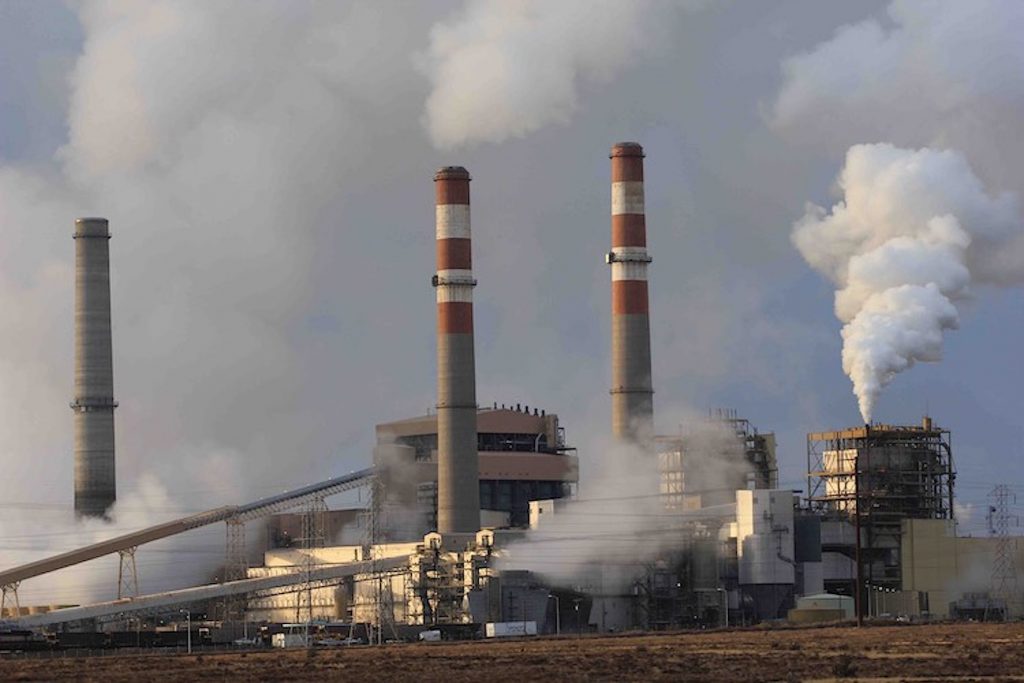A view of the units at the Comanche Generating Station near Pueblo in 2014. Comanche 3 is the unit without painted stripes. (Photo by Allen Best)
Life beyond coal for Colorado begins in 2031. By then, Xcel Energy will have closed its last coal-burning unit, Comanche 3.
What will Xcel do next?
We’ll find out Oct. 15 when Xcel submits its Pueblo Just Transition electric resource plan. It’s called that because Xcel, as a monopoly, has been ordered by state regulators to examine how it can also assist Pueblo, site of the closed coal plant, with new tax base and jobs in this next phase of the energy transition.
Coal plants at Craig, Hayden and Fort Collins will by 2030 have been shuttered or, in the case of Pawnee, near Brush, converted to burn natural gas.
Xcel has agreed to pay property taxes on Comanche until 2040. Does Xcel have projects in mind for Pueblo that can help the utility achieve its 2050 goal of emissions-free electricity?
GET THE MORNING HEADLINES.
I suspect that Xcel will propose another natural gas plant, this one in Pueblo. Nearly all of Colorado’s electrical utilities want new gas plants as they abandon coal. Will these expensive new gas plants be like coal plants 10 or 15 years from now? Comanche 3 was originally projected to retire in 2070. Now, it has become stranded by new technology and economics.
Colorado’s utilities have swiftly left coal behind. It’s hard on local communities but easily justified by lower prices for, first, wind, then solar, both now abetted by plunged prices of battery storage. Utilities have also learned how to integrate renewables without threatening reliability. Colorado’s electricity is expected to be as high as 87% or 88% emissions free by 2030.
Our next steps toward economy-wide decarbonization get more complicated and potentially more expensive. Xcel is the state’s largest utility, but we share the same electrical grid. We all have skin in this game.
We almost certainly will need more electricity. Electric vehicles, which were responsible for 22% of all new car sales in Colorado during the second quarter this year, will elevate demand. So will buildings as we replace natural gas to heat hot water and space.
Plus Xcel seems intent on hosting far more electricity-hungry data centers. Colorado’s population is projected to grow from just shy of 6 million people today to about 7.8 million by 2040.
More solar and wind will also surely be part of Xcel’s proposal. Some of the new resources can be delivered to customers via the 560-mile transmission line being constructed in eastern Colorado. Xcel will almost certainly propose a 60-mile transmission line extension from Lamar to scoop up the wind resources of Baca County, the most valuable wind in Colorado, according to a National Renewable Energy Laboratory study.
More storage? Absolutely. Expect more lithium-ion batteries, which can store electricity for four- to six hours. Iron-air, an emerging storage technology soon to be evaluated in Pueblo, could deliver 100 hours of electricity to back up renewables on those windless days of February.
Pumped-storage hydro? It’s old technology, used in Colorado since 1967 at Xcel’s Cabin Creek project near Georgetown. Two companies with different ideas have proposals in the Yampa Valley, near Hayden and Craig. Both would be very expensive and take years to come on line.
Green hydrogen? Surplus renewable energy could be used to create it from water at Hayden or Pueblo then store it until needed to generate electricity, such as a hot evening in July.
Nuclear? Highly unlikely. It is very, very expensive, something that proponents typically gloss over.
Enhanced geothermal? A smaller bet, but again, still very expensive.
A natural gas plant might be coupled with carbon capture and storage. That technology is still-emerging and in some eyes risky, but the Pueblo area does have promising geology for stowing emissions deep underground. Colorado is preparing regulations governing such injections.
Comanche 3 represents the end of an era of ever-bigger coal-fired power plants. Renewables dominate this future but in different ways. One will be greater connection of utilities in regional power markets to improve efficient sharing of resources. Paradoxically, the other is localized, even neighborhood-scale electrical generation and storage. In this, two electrical cooperatives, Holy Cross Energy and United Power, are among the leading innovators.
As Colorado innovates, the warming bells of climate change clang ever louder. Grand Junction had its hottest summer ever, an average surpassing 80 degrees. Warmer temperatures play a major role in reducing flows of the Colorado River, upon which so many of us depend. We do not have hurricanes, thankfully. Conspiracy theories aside, scientific studies have linked their intensified fury to an obvious cause: a warmer Gulf of Mexico.
Colorado alone cannot solve global warming. Neither can the United States. But perhaps Xcel Energy’s proposal can help Pueblo after the coal era while contributing to a global solution, too.
YOU MAKE OUR WORK POSSIBLE.

